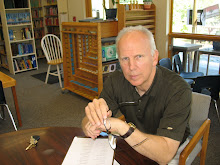It's hard but not impossible to get in to Gaza, if you have applied for clearance ahead of time and have a legitimate purpose.
The young Israeli woman only asks a few questions, is cordial, professional and polite.
Soon, we are through passport control, and the turnstiles, and making the long trek down the covered walkway that stretches out -- half a mile? three quarters of a mile? -- across "no-man's land." There are thin vertical metal strips on the sides of the walkway, caging us in, strong enough to prevent us from straying from the path but not strong enough, it occurs to me, to deflect a bullet.
Thankfully, at the far end Hala is expecting us, and ushers us through Hamas security and into a taxi and into Gaza.
First impressions? If the Israelis intended to bomb Gaza into the stone age, they may have succeeded, since all I see for the first half mile is rubble. Hala assures us that this is the part that was most devastated by the Israeli incursion of 2008/09 and not representative of Gaza City proper. We pass two young boys driving a cart created from a car frame and pulled by a laboring horse. The cart is piled with rubble the industrious boys have collected. Soon the goal of their efforts comes into site: a little two-man factory for crushing rock, and transforming it into cinder block. When life gives you lemons, make lemonade. When life gives you rubble, make cinder block!
Soon we are leaving North Gaza and entering Gaza City, and with every meter we travel the buildings rise and crowd together, the streets become more and more choked with traffic, the people and noise and activity and pollution increase exponentially as we enter one of the most densely populated places on earth.
Since many who read this will have little knowledge of Gaza, I will give a little history at this point. The Gaza strip as it is called in the west, is a piece of land along the eastern Mediterranean bordered by Egypt on the south, and by Israel on the east and north. At a mere 25 miles long, and varying between 3 and 7 miles wide, it encompasses an area of only 146 square miles, but has a population of well over one and a half million people, mostly refugees or the children of refugees.
Before 1948 it is estimated that only about 60,000 people lived in Gaza. Within 20 years the population had grown to 6 times that number as thousands of Palestinians fled or were evicted from the villages from Jaffa south. They crossed no international border. Many undoubtedly thought they would go back to their villages in a few weeks or months. In fact, they been able to go back. Over the years Gaza has been under the control of Egypt or Israel. But, since Israel pulled out its settlers and especially since the takeover of the Gazan government by Hamas in 2007, the borders with Egypt and Israel are closed, and the Gazan people are trapped, effectively creating what some have called the world's largest prison. Unemployment exceeds 60%. Some 80% of the population lives below any international standard of poverty. There is no real economy, unless you count the underground (literally) economy of goods brought through tunnels from Egypt, or the welfare economy of international assistance.
And yet, for all of this, the Gazans I met were universally friendly, kind and polite.
I'm sure there is plenty of blame for this situation to go around and hardly anyone in the region or in the west is blameless. The only exception may be, ironically, the Gazan people, who are simply trying to survive and find a better life for their children than they have had.
Sunday, February 6, 2011
Subscribe to:
Posts (Atom)

